2019 KIA NIRO HYBRID EV oil level
[x] Cancel search: oil levelPage 492 of 611
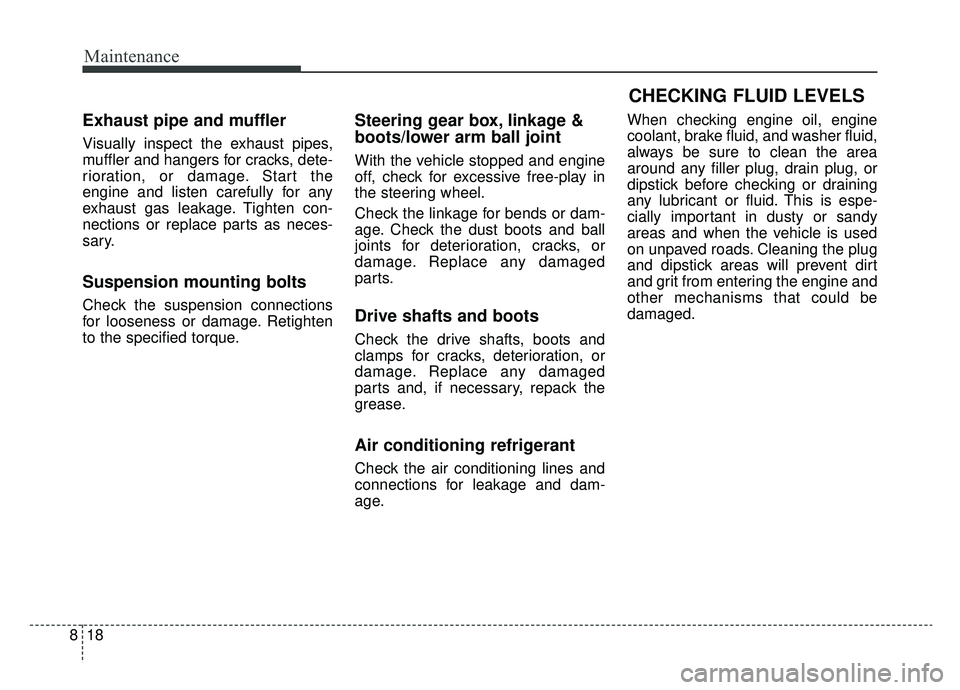
Maintenance
18
8
Exhaust pipe and muffler
Visually inspect the exhaust pipes,
muffler and hangers for cracks, dete-
rioration, or damage. Start the
engine and listen carefully for any
exhaust gas leakage. Tighten con-
nections or replace parts as neces-
sary.
Suspension mounting bolts
Check the suspension connections
for looseness or damage. Retighten
to the specified torque.
Steering gear box, linkage &
boots/lower arm ball joint
With the vehicle stopped and engine
off, check for excessive free-play in
the steering wheel.
Check the linkage for bends or dam-
age. Check the dust boots and ball
joints for deterioration, cracks, or
damage. Replace any damaged
parts.
Drive shafts and boots
Check the drive shafts, boots and
clamps for cracks, deterioration, or
damage. Replace any damaged
parts and, if necessary, repack the
grease.
Air conditioning refrigerant
Check the air conditioning lines and
connections for leakage and dam-
age. When checking engine oil, engine
coolant, brake fluid, and washer fluid,
always be sure to clean the area
around any filler plug, drain plug, or
dipstick before checking or draining
any lubricant or fluid. This is espe-
cially important in dusty or sandy
areas and when the vehicle is used
on unpaved roads. Cleaning the plug
and dipstick areas will prevent dirt
and grit from entering the engine and
other mechanisms that could be
damaged.
CHECKING FLUID LEVELS
Page 493 of 611
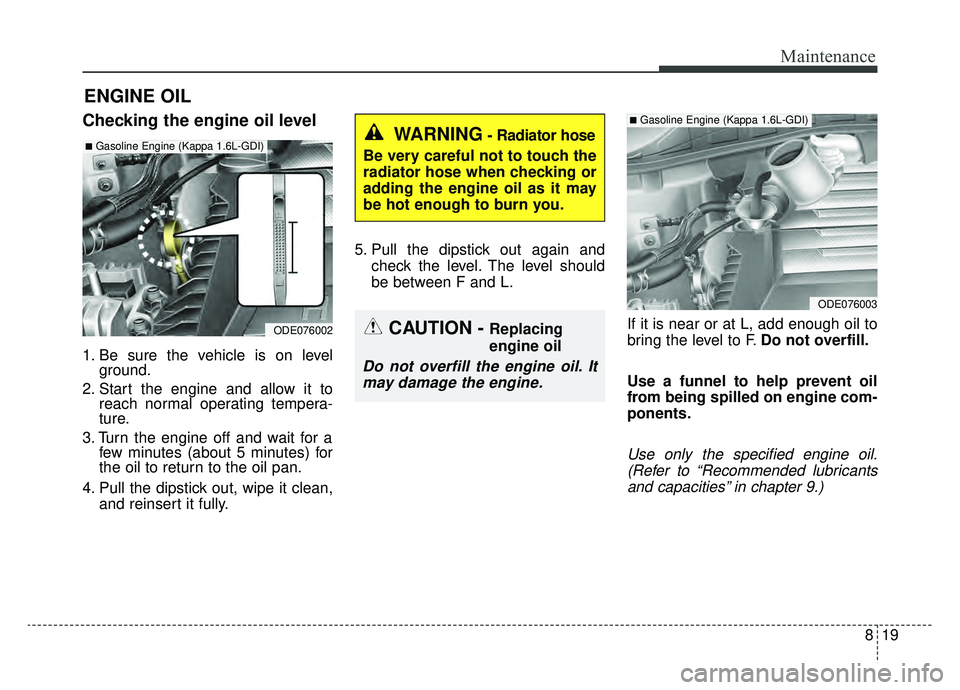
819
Maintenance
ENGINE OIL
Checking the engine oil level
1. Be sure the vehicle is on levelground.
2. Start the engine and allow it to reach normal operating tempera-
ture.
3. Turn the engine off and wait for a few minutes (about 5 minutes) for
the oil to return to the oil pan.
4. Pull the dipstick out, wipe it clean, and reinsert it fully. 5. Pull the dipstick out again and
check the level. The level should
be between F and L.
If it is near or at L, add enough oil to
bring the level to F.Do not overfill.
Use a funnel to help prevent oil
from being spilled on engine com-
ponents.
Use only the specified engine oil. (Refer to “Recommended lubricantsand capacities” in chapter 9.)
CAUTION - Replacing
engine oil
Do not overfill the engine oil. Itmay damage the engine.
WARNING- Radiator hose
Be very careful not to touch the
radiator hose when checking or
adding the engine oil as it may
be hot enough to burn you.
ODE076002
■Gasoline Engine (Kappa 1.6L-GDI)
ODE076003
■Gasoline Engine (Kappa 1.6L-GDI)
Page 500 of 611
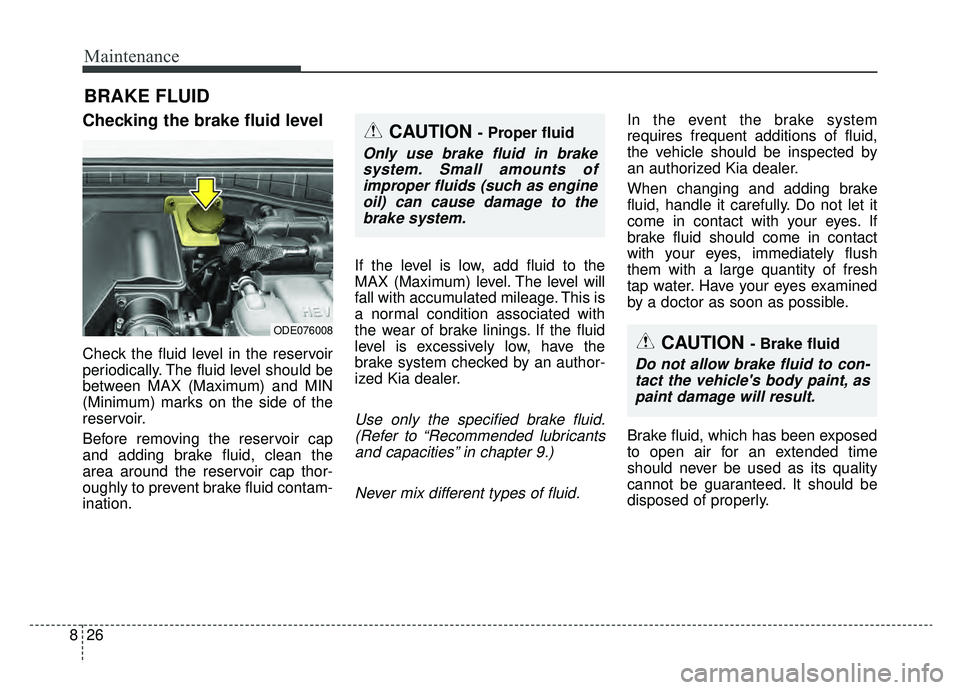
Maintenance
26
8
BRAKE FLUID
Checking the brake fluid level
Check the fluid level in the reservoir
periodically. The fluid level should be
between MAX (Maximum) and MIN
(Minimum) marks on the side of the
reservoir.
Before removing the reservoir cap
and adding brake fluid, clean the
area around the reservoir cap thor-
oughly to prevent brake fluid contam-
ination. If the level is low, add fluid to the
MAX (Maximum) level. The level will
fall with accumulated mileage. This is
a normal condition associated with
the wear of brake linings. If the fluid
level is excessively low, have the
brake system checked by an author-
ized Kia dealer.
Use only the specified brake fluid.
(Refer to “Recommended lubricantsand capacities” in chapter 9.)
Never mix different types of fluid.
In the event the brake system
requires frequent additions of fluid,
the vehicle should be inspected by
an authorized Kia dealer.
When changing and adding brake
fluid, handle it carefully. Do not let it
come in contact with your eyes. If
brake fluid should come in contact
with your eyes, immediately flush
them with a large quantity of fresh
tap water. Have your eyes examined
by a doctor as soon as possible.
Brake fluid, which has been exposed
to open air for an extended time
should never be used as its quality
cannot be guaranteed. It should be
disposed of properly.
CAUTION - Brake fluid
Do not allow brake fluid to con-tact the vehicle's body paint, aspaint damage will result.
CAUTION - Proper fluid
Only use brake fluid in brakesystem. Small amounts ofimproper fluids (such as engineoil) can cause damage to thebrake system.
ODE076008
Page 501 of 611
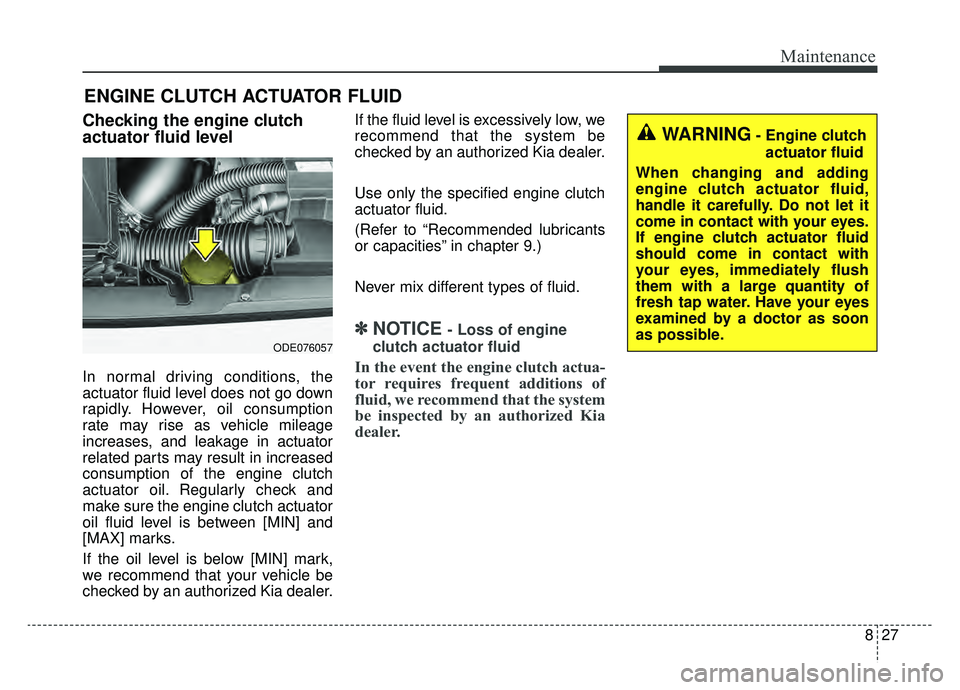
827
Maintenance
ENGINE CLUTCH ACTUATOR FLUID
Checking the engine clutch
actuator fluid level
In normal driving conditions, the
actuator fluid level does not go down
rapidly. However, oil consumption
rate may rise as vehicle mileage
increases, and leakage in actuator
related parts may result in increased
consumption of the engine clutch
actuator oil. Regularly check and
make sure the engine clutch actuator
oil fluid level is between [MIN] and
[MAX] marks.
If the oil level is below [MIN] mark,
we recommend that your vehicle be
checked by an authorized Kia dealer.If the fluid level is excessively low, we
recommend that the system be
checked by an authorized Kia dealer.
Use only the specified engine clutch
actuator fluid.
(Refer to “Recommended lubricants
or capacities” in chapter 9.)
Never mix different types of fluid.
✽ ✽
NOTICE - Loss of engine
clutch actuator fluid
In the event the engine clutch actua-
tor requires frequent additions of
fluid, we recommend that the system
be inspected by an authorized Kia
dealer.
WARNING- Engine clutch actuator fluid
When changing and adding
engine clutch actuator fluid,
handle it carefully. Do not let it
come in contact with your eyes.
If engine clutch actuator fluid
should come in contact with
your eyes, immediately flush
them with a large quantity of
fresh tap water. Have your eyes
examined by a doctor as soon
as possible.
ODE076057
Page 524 of 611
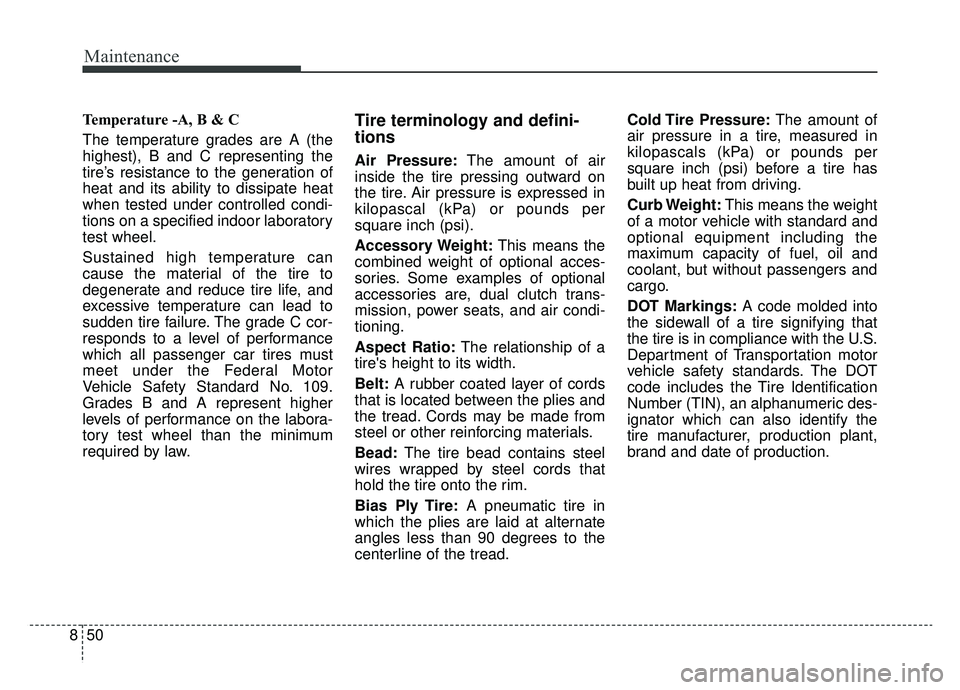
Maintenance
50
8
Temperature -A, B & C
The temperature grades are A (the
highest), B and C representing the
tire’s resistance to the generation of
heat and its ability to dissipate heat
when tested under controlled condi-
tions on a specified indoor laboratory
test wheel.
Sustained high temperature can
cause the material of the tire to
degenerate and reduce tire life, and
excessive temperature can lead to
sudden tire failure. The grade C cor-
responds to a level of performance
which all passenger car tires must
meet under the Federal Motor
Vehicle Safety Standard No. 109.
Grades B and A represent higher
levels of performance on the labora-
tory test wheel than the minimum
required by law.Tire terminology and defini-
tions
Air Pressure: The amount of air
inside the tire pressing outward on
the tire. Air pressure is expressed in
kilopascal (kPa) or pounds per
square inch (psi).
Accessory Weight: This means the
combined weight of optional acces-
sories. Some examples of optional
accessories are, dual clutch trans-
mission, power seats, and air condi-
tioning.
Aspect Ratio: The relationship of a
tire's height to its width.
Belt: A rubber coated layer of cords
that is located between the plies and
the tread. Cords may be made from
steel or other reinforcing materials.
Bead: The tire bead contains steel
wires wrapped by steel cords that
hold the tire onto the rim.
Bias Ply Tire: A pneumatic tire in
which the plies are laid at alternate
angles less than 90 degrees to the
centerline of the tread. Cold Tire Pressure:
The amount of
air pressure in a tire, measured in
kilopascals (kPa) or pounds per
square inch (psi) before a tire has
built up heat from driving.
Curb Weight: This means the weight
of a motor vehicle with standard and
optional equipment including the
maximum capacity of fuel, oil and
coolant, but without passengers and
cargo.
DOT Markings: A code molded into
the sidewall of a tire signifying that
the tire is in compliance with the U.S.
Department of Transportation motor
vehicle safety standards. The DOT
code includes the Tire Identification
Number (TIN), an alphanumeric des-
ignator which can also identify the
tire manufacturer, production plant,
brand and date of production.
Page 603 of 611

Index
4I
Defroster . . . . . . . . . . . . . . . . . . . . . . . . . . . . . . . . . . . 4-\
129Rear window defroster . . . . . . . . . . . . . . . . . . . . . . 4-129
Dimensions . . . . . . . . . . . . . . . . . . . . . . . . . . . . . . . . . . . 9-\
2
Door locks. . . . . . . . . . . . . . . . . . . . . . . . . . . . . . . . . . . 4-\
20 Child-protector rear door lock . . . . . . . . . . . . . . . . . 4-23
Operating door locks from inside the vehicle . . . . . 4-21
Operating door locks from outside the vehicle . . . . 4-20
Driver Attention Alert system (DAA). . . . . . . . . . . . . . 6-84 Resetting the system . . . . . . . . . . . . . . . . . . . . . . . . 6-86
System disabled . . . . . . . . . . . . . . . . . . . . . . . . . . . . 6-86
System malfunction . . . . . . . . . . . . . . . . . . . . . . . . . 6-86
System setting and activation . . . . . . . . . . . . . . . . . . 6-84
Dual Clutch Transmission (DCT). . . . . . . . . . . . . . . . . 6-14 Dual Clutch Transmission operation . . . . . . . . . . . . 6-14
Good driving practices . . . . . . . . . . . . . . . . . . . . . . . 6-21
Economical operation . . . . . . . . . . . . . . . . . . . . . . . . . . 6-89
Electrical Equipment (U.S. only) . . . . . . . . . . . . . . . . . 9-15 Installation of a mobile two-way radio system . . . . 9-15
Emergency starting . . . . . . . . . . . . . . . . . . . . . . . . . . . . . 7-5 Before jump starting (for Hybrid) . . . . . . . . . . . . . . . 7-5
Jump starting . . . . . . . . . . . . . . . . . . . . . . . . . . . . . . . 7-7
Method to disconnect the (-) cable for regularmaintenance (For Hybrid) . . . . . . . . . . . . . . . . . . . . 7-7 Push-starting . . . . . . . . . . . . . . . . . . . . . . . . . . . . . . . . 7-9
Emission control system . . . . . . . . . . . . . . . . . . . . . . . 8-106 Crankcase emission control system . . . . . . . . . . . . 8-106
Evaporative emission control(Including ORVR :Onboard Refueling Vapor Recovery) system. . . . 8-106
Exhaust emission control system . . . . . . . . . . . . . . 8-107
Engine . . . . . . . . . . . . . . . . . . . . . . . . . . . . . . . . . . . . \
. . . 9-2
Engine clutch actuator fluid . . . . . . . . . . . . . . . . . . . . . 8-27 Checking the engine clutch actuator fluid level. . . . 8-27
Engine compartment . . . . . . . . . . . . . . . . . . . . . . . . 2-6, 8-3
Engine number . . . . . . . . . . . . . . . . . . . . . . . . . . . . . . . 9-10
Engine oil . . . . . . . . . . . . . . . . . . . . . . . . . . . . . . . . . . . 8-\
19 Changing the engine oil and filter . . . . . . . . . . . . . . 8-20
Checking the engine oil level . . . . . . . . . . . . . . . . . . 8-19
Engine start/stop button . . . . . . . . . . . . . . . . . . . . . . . . . 6-9 Engine start/stop button position . . . . . . . . . . . . . . . . 6-9
Illuminated engine start/stop button. . . . . . . . . . . . . . 6-9
Starting the hybrid system . . . . . . . . . . . . . . . . . . . . 6-11
Explanation of scheduled maintenance items . . . . . . . 8-15
Exterior features . . . . . . . . . . . . . . . . . . . . . . . . . . . . . 4-165 Roof rack . . . . . . . . . . . . . . . . . . . . . . . . . . . . . . . . 4-165
Exterior overview . . . . . . . . . . . . . . . . . . . . . . . . . . . . . . 2-2
Folding key . . . . . . . . . . . . . . . . . . . . . . . . . . . . . . . . . . . 4-\
4 Battery replacement . . . . . . . . . . . . . . . . . . . . . . . . . . 4-7
Immobilizer system . . . . . . . . . . . . . . . . . . . . . . . . . . 4-8
E
D
F
Page 609 of 611
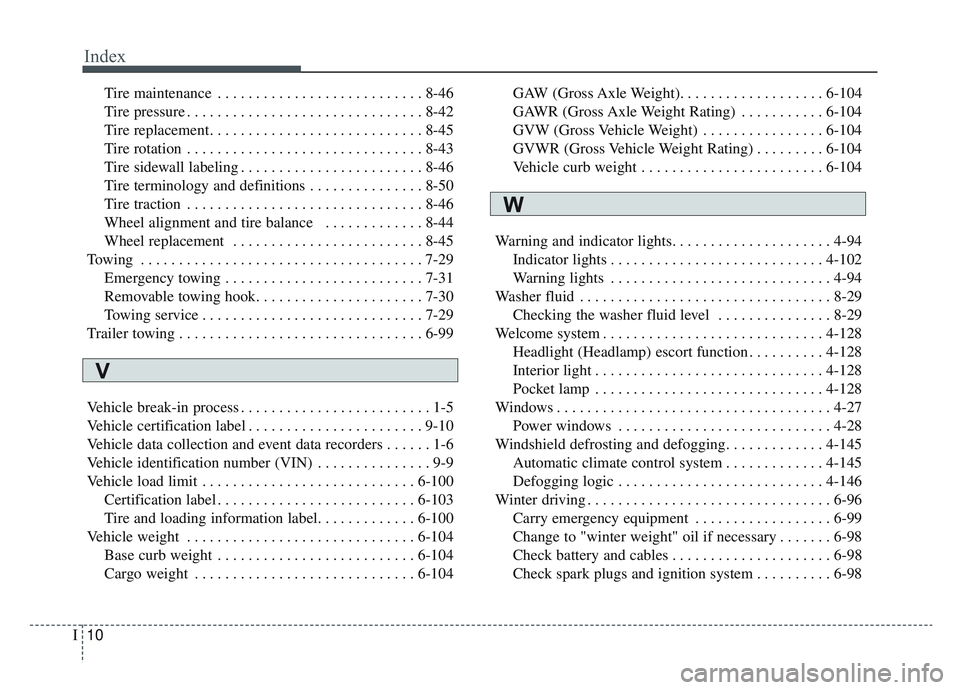
Index
10I
Tire maintenance . . . . . . . . . . . . . . . . . . . . . . . . . . . 8-46
Tire pressure . . . . . . . . . . . . . . . . . . . . . . . . . . . . . . . 8-42
Tire replacement . . . . . . . . . . . . . . . . . . . . . . . . . . . . 8-45
Tire rotation . . . . . . . . . . . . . . . . . . . . . . . . . . . . . . . 8-43
Tire sidewall labeling . . . . . . . . . . . . . . . . . . . . . . . . 8-46
Tire terminology and definitions . . . . . . . . . . . . . . . 8-50
Tire traction . . . . . . . . . . . . . . . . . . . . . . . . . . . . . . . 8-46
Wheel alignment and tire balance . . . . . . . . . . . . . 8-44
Wheel replacement . . . . . . . . . . . . . . . . . . . . . . . . . 8-45
Towing . . . . . . . . . . . . . . . . . . . . . . . . . . . . . . . . . . . . \
. 7-29 Emergency towing . . . . . . . . . . . . . . . . . . . . . . . . . . 7-31
Removable towing hook. . . . . . . . . . . . . . . . . . . . . . 7-30
Towing service . . . . . . . . . . . . . . . . . . . . . . . . . . . . . 7-29
Trailer towing . . . . . . . . . . . . . . . . . . . . . . . . . . . . . . . . 6-99
Vehicle break-in process . . . . . . . . . . . . . . . . . . . . . . . . . 1-5
Vehicle certification label . . . . . . . . . . . . . . . . . . . . . . . 9-10
Vehicle data collection and event data recorders . . . . . . 1-6
Vehicle identification number (VIN) . . . . . . . . . . . . . . . 9-9
Vehicle load limit . . . . . . . . . . . . . . . . . . . . . . . . . . . . 6-100 Certification label . . . . . . . . . . . . . . . . . . . . . . . . . . 6-103
Tire and loading information label. . . . . . . . . . . . . 6-100
Vehicle weight . . . . . . . . . . . . . . . . . . . . . . . . . . . . . . 6-104 Base curb weight . . . . . . . . . . . . . . . . . . . . . . . . . . 6-104
Cargo weight . . . . . . . . . . . . . . . . . . . . . . . . . . . . . 6-104 GAW (Gross Axle Weight). . . . . . . . . . . . . . . . . . . 6-104
GAWR (Gross Axle Weight Rating) . . . . . . . . . . . 6-104
GVW (Gross Vehicle Weight) . . . . . . . . . . . . . . . . 6-104
GVWR (Gross Vehicle Weight Rating) . . . . . . . . . 6-104
Vehicle curb weight . . . . . . . . . . . . . . . . . . . . . . . . 6-104
Warning and indicator lights. . . . . . . . . . . . . . . . . . . . . 4-94 Indicator lights . . . . . . . . . . . . . . . . . . . . . . . . . . . . 4-102
Warning lights . . . . . . . . . . . . . . . . . . . . . . . . . . . . . 4-94
Washer fluid . . . . . . . . . . . . . . . . . . . . . . . . . . . . . . . . . 8-29 Checking the washer fluid level . . . . . . . . . . . . . . . 8-29
Welcome system . . . . . . . . . . . . . . . . . . . . . . . . . . . . . 4-128 Headlight (Headlamp) escort function . . . . . . . . . . 4-128
Interior light . . . . . . . . . . . . . . . . . . . . . . . . . . . . . . 4-128
Pocket lamp . . . . . . . . . . . . . . . . . . . . . . . . . . . . . . 4-128
Windows . . . . . . . . . . . . . . . . . . . . . . . . . . . . . . . . . . . . \
4-27 Power windows . . . . . . . . . . . . . . . . . . . . . . . . . . . . 4-28
Windshield defrosting and defogging. . . . . . . . . . . . . 4-145 Automatic climate control system . . . . . . . . . . . . . 4-145
Defogging logic . . . . . . . . . . . . . . . . . . . . . . . . . . . 4-146
Winter driving . . . . . . . . . . . . . . . . . . . . . . . . . . . . . . . . 6-96 Carry emergency equipment . . . . . . . . . . . . . . . . . . 6-99
Change to "winter weight" oil if necessary . . . . . . . 6-98
Check battery and cables . . . . . . . . . . . . . . . . . . . . . 6-98
Check spark plugs and ignition system . . . . . . . . . . 6-98
V
W